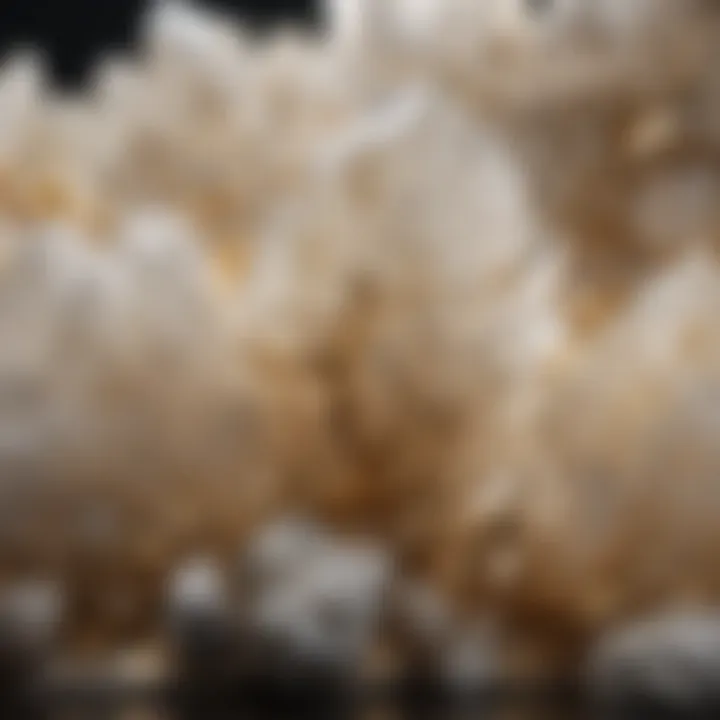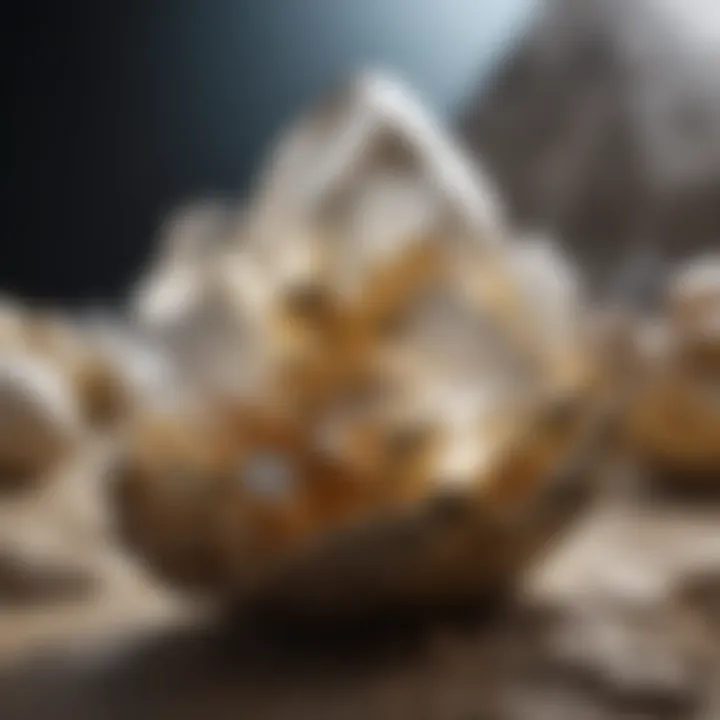Exploring Gold's Role in White Quartz


Intro
Gold in white quartz brings to mind a delicate and aesthetically pleasing juxtaposition. This glorious union reveals a distinctive allure that draws the eye and captures the imagination. The significance of this pairing extends beyond mere visuals—it encapsulates a rich tapestry of geological processes, cultural histories, and economic implications.
In this exploration, we aim to uncover how these two elements coexist in nature and what makes them sought after by collectors and enthusiasts alike. The juxtaposition of the gleaming yellows of gold against the pure whites of quartz offers not just a stunning display but also serves as a reminder of incidents that shaped our Earth over millions of years. Exploring this relationship invites us to appreciate not only their visual symbiosis but also the deeper meanings each mineral holds in the natural world and among collectors.
Emphasizing the interplay of scientific understanding, aesthetic appeal, and cultural relevance, this narrative will present a comprehensive guide, illuminating how gold might not merely be an ornament, but rather a geological tale etched in time.
Featured Collectible of the Month
Overview
Gold-infused quartz pieces exemplify the dynamic interplay of these minerals. Each specimen varies greatly depending on its origin, creating a unique fingerprint that beckons both amateur and seasoned collectors. The shimmering flecks of gold often form intricate patterns within the quartz, making these collections even more special.
Historical Significance
The relationship between gold and quartz isn’t merely a modern fascination. Historically, quartz has been mined for centuries, often seen as a stone of power and beauty. The gold rushes of the 19th century led to the discovery of numerous quartz deposits containing gold. The residents of these boomtowns often incorporated gold quartz pieces into jewelry, highlighting their value both as currency and as art.
"Gold in white quartz is not just a mineral combination; it tells a story of the Earth’s history and human endeavor to unearth its riches."
Identification Techniques
Visual Characteristics
In identifying specimens of gold in white quartz, collectors should look for the following features:
- Color Variations: Recognizing the contrast between the yellow gold and white quartz is essential. Pure gold appears bright and shiny, with unyielding brilliance against the backdrop of translucent or milky white quartz.
- Texture: The surface might vary from smooth to slightly rough, indicating inclusions or formations of the gold within.
- Patterning: Intricate vein-like patterns are often a hallmark of high-quality specimens, where gold appears to flow within the quartz matrix.
Resources for Identification
For those interested in delving deeper into the art of identifying gold quartz specimens, here are some valuable resources:
- Wikipedia – A general overview of quartz and its varieties can be beneficial.
- Britannica – Use this for insights into mineral properties and historical contexts.
- Reddit – Community discussions often yield practical tips for identification.
- Facebook – Explore collector groups where enthusiasts share knowledge and images of their prized specimens.
Understanding Quartz
In this article, grasping the nature of quartz is paramount as it lays the groundwork for appreciating the relationship between gold and white quartz. Quartz is not just an ordinary mineral; it's a vital component of the Earth’s crust and holds numerous geological secrets. Understanding its composition, formation, and varieties sheds light on how gold intermingles with this crystalline structure.
Composition of Quartz
Quartz is primarily composed of silicon dioxide (SiO2), which is a simple yet fascinating compound. This combination creates a crystalline structure noted for its hardness—coming in at 7 on the Mohs scale—and various optical properties. Its colorlessness and clarity often mislead enthusiasts, making them overlook that quartz can also appear in different shades due to the presence of impurities.
- Silicon Dioxide (SiO2): This is the backbone of quartz, giving it resilience and appealing aesthetics.
- Impurities: These elements, like iron or titanium, can introduce distinct hues into quartz, expanding the variety of forms it can take.
When examining quartz in the context of gold deposits, it's essential to realize that the mineral's properties influence how and where these valuable elements are found.
Formation of Quartz
The formation of quartz is an intricate process that occurs both in igneous and metamorphic settings. Understanding it can illuminate why gold appears in quartz veins. Quartz can crystallize from magma as it cools, but it can also form through hydrothermal processes where hot, mineral-rich fluids intermingle with existing rock structures.
Here's a snapshot of the processes involved:
- Primary Crystallization: This occurs in molten rock where quartz emerges as a byproduct of cooling magma.
- Secondary Formation: This happens when quartz is deposited from vapor or fluids during metamorphism, often associated with volcanic activity.
These geological narratives are crucial in understanding how the stunning interplay of gold and quartz occurs within nature.
Varieties of Quartz
Quartz isn’t a one-size-fits-all mineral; it comes in a wide array of varieties that enthusiasts and collectors desperately seek. Each type of quartz tells its own unique story and holds different value in collector circles. Common varieties include:
- Amethyst: Known for its purple hues, which result from iron impurities, this variety is shrouded in history and cultural lore.
- Smoky Quartz: Ranging from light gray to nearly black, its captivating color is a product of natural state of radiation.
- Citrine: A more energetic yellow variant, often considered a stone of prosperity, it is prized for its vibrant appearance.
In the context of gold, the quartz varieties can influence value and desirability among collectors. For instance, the presence of gold in amethyst can considerably increase its appeal and price. Collectors often assess the individual characteristics of each quartz type to discern their authentic nature and potential worth.
Geological Processes Involved
Understanding how gold exists in white quartz necessitates a deep dive into various geological processes. These processes, namely hydrothermal activity, metamorphic transformations, and weathering and erosion, architect the environment where this distinctive mineral combination can thrive. The interplay of these processes not only contributes to the formation of gold-bearing quartz deposits but also distinguishes the aesthetic qualities and practical uses of such materials for collectors and enthusiasts alike.


Hydrothermal Activity
Hydrothermal activity plays a pivotal role in the creation of gold in quartz. Essentially, this involves hot, mineral-laden water that permeates through the earth's crust. As temperatures and pressures shift, these solutions may deposit gold along fractures or cavities within quartz veins.
What makes this process fascinating is the diverse conditions under which it occurs. For instance, the Goldfields of Victoria, Australia, are renowned for their stunning quartz veins formed from such hydrothermal solutions. Here, the gold intricately weaves into the matrix of the quartz, giving it a unique beauty that collectors covet. Beyond Australia's shores, other places around the globe, like California’s Sierra Nevada mountains, also display how hydrothermal veins can lead to rich gold deposits.
The hydrothermal process emphasizes the significance of fluid movement within the geology of gold-bearing regions. It opens a window into understanding where collectors might find rich specimens and how the gold found within those quartz formations developed over time.
Metamorphic Processes
Metamorphism can transform pre-existing rocks into something entirely new, and this is another avenue through which gold is often found associated with quartz. In areas where intense heat and pressure act on existing rocks, gold may either remobilize or deposit itself in new locations within the quartz structures.
A striking example is the Ural Mountains in Russia, where metamorphic processes have created considerable concentrations of gold-silicate ores, often involving quartz formation. The result is a stunning array of quartz crystals exhibiting rich gold veins, sought after for both their beauty and intrinsic value.
The metamorphic cycle aids in producing not just gold deposits but also influences the structural characteristics of quartz itself, shaping its durability and appeal among collectors.
Weathering and Erosion
Finally, the processes of weathering and erosion cannot be overlooked. Over vast periods, weathering breaks down rocks, allowing minerals, including gold, to be released and transported. Erosion, on the other hand, ensures that these minerals find their way into sedimentary deposits or are exposed at the earth's surface. In areas such as Zimbabwe’s gold belt, this weathering process has revealed significant gold-enriched quartz outcrops, making them prime targets for mining.
"The beauty of nature is that reliable geological processes can uncover the treasures beneath our feet, literally turning rocks into gold."
By recognizing how weathering and erosion influence the distribution of gold, collectors gain insight into where they might look when scouring the earth for striking quartz specimens.
In summary, the geological processes involved in the formation of gold in white quartz are complex and interlinked. From the fiery depths of hydrothermal systems to the transformative powers of metamorphism and the dynamic forces of weathering, each facet enriches our understanding of these remarkable natural deposits. Moreover, these processes highlight the significance of context in the appreciation of quartz and gold, proving a fascinating journey for enthusiasts wanting to engage with the natural world.
Gold and Its Properties
Gold holds a prominent place in the study of minerals, especially when paired with quartz. Its unique qualities make it a subject of fascination for both collectors and scientists. Understanding the properties of gold not only informs collectors about its visual appeal but also aids in recognizing its geological significance in white quartz formations. In this section, we will explore the physical and chemical properties of gold, shedding light on why it stands out so distinctively in nature.
Physical Characteristics of Gold
When it comes to physical properties, gold is unmistakable. Its luster, often described as metallic shine, is different from most minerals. In its pure form, gold has a bright yellow hue that can shift in color based on its alloying elements. The densities of gold are notably high – approximately 19.3 grams per cubic centimeter. This heft can be quite the eye-opener for collectors inspecting quartz specimens.
The ductility of gold is another intriguing aspect. A mere ounce of this metal can be drawn into a wire over 50 miles long. This quality, coupled with its malleability, highlights why gold is often favored in crafting exquisite jewelry but there's more to gold than aesthetics.
Key Physical Traits of Gold:
- Heavy and dense
- High luster
- Excellent malleability and ductility
- Does not tarnish easily
These attributes make gold perfect for both practical uses and as a collectible mineral in quartz veins.
Chemical Properties of Gold
Chemically speaking, gold is one of the least reactive elements, which contributes to its durability. It has the atomic number 79 and is categorized as a transition metal. Gold does not react readily with oxygen and, consequently, does not corrode or rust like many other metals. This lack of reactivity means that gold specimens in quartz retain their brilliance over millennia.
Gold primarily occurs in two forms: elemental gold and in compounds. The atomic structure of gold contributes to its stability. It’s often found within quartz veins, where it formed through various geological processes. Gold tends to bond with other elements like silver and copper, creating different alloys. This makes each sample of gold in quartz potentially unique due to variations in its chemical make-up.
Significant Chemical Properties of Gold:
- Atomic number: 79
- Highly resistant to corrosion
- Occurs as alloys with other metals
These properties not only define gold's beauty but also play a vital role in determining its formation within quartz. Excelling in both form and function, the study of gold in white quartz is not merely academic; it's a portal to understanding geological processes and economic significance in our world.
"Gold, more than just a metal, is a story of earth's history carved in time."
In summary, knowing the physical and chemical properties of gold enhances the comprehension of its role in white quartz. This understanding stimulates a deeper appreciation for its natural beauty and geological importance.
Occurrence of Gold in Quartz
The presence of gold within quartz isn't just a geological curiosity; it's a significant aspect that captures the interest of geologists, collectors, and enthusiasts alike. This section will explore the intricate ways in which these two minerals come together, shedding light on the formation mechanisms, the visual characteristics that make them unique, and the common locations where such occurrences can be found. Understanding these elements is crucial for anyone who wants to appreciate the beauty and implications of gold in quartz.
Formation Mechanisms
The genesis of gold within quartz can be traced back to a variety of geological processes. One of the primary mechanisms is associated with hydrothermal fluids—hot, mineral-rich water that can move through cracks in rocks. As these fluids cool, they can precipitate gold and other minerals, depositing them in quartz veins. This creates the striking visual contrast that collectors find appealing.
Another method involves metamorphic processes. As rocks are subjected to extreme heat and pressure, elements may become mobilized and can settle into existing quartz formations. This process can yield gold that is both visually embedded in quartz and can be extracted through mining.


Furthermore, erosion plays a vital role. Over time, weathering can free gold particles that were housed within their quartz hosts, making them available for collection. This natural cooperation between gold and quartz speaks to the dynamic nature of Earth's geology.
Visual Characteristics
When gold appears in quartz, the result can range from subtle flecks to bold, eye-catching veins. The stark contrast between the bright, metallic yellow of gold and the crystalline white of quartz creates a striking aesthetic. Collectors often look for areas where gold can be seen coursing through the quartz, as these visible deposits often indicate a high grade of gold within.
Some common visual traits to be aware of include:
- Gold Flakes: Tiny dispersed specks that can be found throughout the quartz matrix.
- Gold Veins: Distinct lines of gold that run through the quartz, which are often a sign of higher concentrations.
- Golden Coating: In certain instances, the gold can form a thin coating on the quartz surface, providing a unique sheen that reflects light beautifully.
These visual characteristics not only add to the rock's beauty but also help identify the quality and potential value of the specimen.
Common Locations
Gold in quartz is found in several geological settings around the globe. Many notable regions have gained fame for their rich deposits, making them popular destinations for both amateur and professional prospectors.
Some prominent locations include:
- California: The Sierra Nevada region, heavily influenced by historic gold rushes, has a wealth of quartz-gold deposits.
- Alaska: Vast and often untouched, the Alaskan wilderness harbors rich gold veins embedded in quartz.
- South Africa: The Witwatersrand basin is known for significant deposits where gold quartz formations are predominant.
- Australia: Particularly in New South Wales, where both natural beauty and rich minerals intertwine, quartz veins with gold are plentiful.
Understanding where to look is essential for collectors, not only to discover beauty but also to appreciate the cultural and historical significance tied to these locations.
"Whether you're a hobbyist or a seasoned collector, knowing the landscapes that nurture these natural gems is key to truly understanding their value."
In sum, the occurrence of gold in quartz is multifaceted. It’s a narrative woven through geological time, marked by formation, visual beauty, and fruitful locations—the blend of which captivates both the mind and the eye.
Cultural Significance
The cultural significance of gold in white quartz cannot be overstated. As a striking combination of two distinct elements, this union has stirred the imagination and shaped the beliefs of various societies across centuries. From ancient civilizations to contemporary collectors, the appeal of gold-infused quartz transcends mere aesthetics. It embodies wealth, power, and beauty, making it a vital part of human history and a fascinating subject for those engaged in geological or cultural studies.
Historical Uses of Gold and Quartz
Throughout history, gold has been considered a symbol of affluence and status. Ancient Egyptians, for instance, revered gold not just for its luxurious qualities but for its perceived divine connections. They crafted intricate jewelry embedded with quartz, believing that these stones possessed protective qualities. Similarly, the use of quartz and gold in religious artifacts signified not only material wealth but also spiritual elevation.
In ancient Rome, gold mixed with quartz was often used in ornamental pieces, showcasing the importance of these materials in signifying social standing. Warriors and leaders adorned themselves with gold jewelry intricately set with quartz, as it was seen as a mark of honor and prestige. This trend of utilizing both gold and quartz in high-value items continued through the ages, flourishing in the European Renaissance where the join of the two suggested artful sophistication and excellence.
"Gold in quartz has resonated through time as more than just a luxury; it connects us to the narratives of human aspiration and artistry."
As we transitioned into the modern era, these materials found their way into the world of technology and fashion. The combination highlighted not only elegance but also engineering brilliance, especially in watchmaking where quartz and gold are often working side by side. Collectors value these items not just for their beauty, but for their historical narratives that are rich and multifaceted.
Symbolism in Various Cultures
The symbolism of gold and quartz varies significantly among cultures, often reflecting their core values and beliefs. In Western cultures, the gleam of gold in quartz embodies prosperity and success. This notion is richly reflected in jewelry and decor. Moreover, its use in wedding rings and ceremonial pieces showcases the belief that these materials can enhance relationships and elevate life’s important moments.
Conversely, in Asian traditions, the combination takes on more auspicious meanings. In Chinese culture, gold is synonymous with wealth and good fortune. Therefore, gold-infused quartz is often used in Feng Shui practices, where it's believed to harness positive energy that can enrich a space or project.
In indigenous cultures, quartz plays an even more profound role. Native American tribes, for instance, attach spiritual significance to quartz crystals, considering them as tools for healing and connecting with the spiritual world. When infused with gold, this connection to nature takes on a new dimension, linking the material to life force and natural beauty.
This melding of beliefs and values across cultures highlights gold in quartz as a bridge that unites us in an appreciation of nature's artistry while serving as an enduring testament to human creativity and aspiration.
Economic Impact
The economic significance of gold in white quartz cannot be overstated. As a natural resource, both gold and quartz have generated considerable interest and investment over the years. This section explores various aspects of this relationship, from mining practices to market trends, offering insights for rock and mineral collectors as well as investors looking at the potential opportunities found within these two materials.
Mining Practices
Mining practices associated with gold embedded in white quartz can vary considerably. Depending on where one digs, this can influence the processes used for extraction. Traditional mining, such as panning in riverbeds or placer mining, allows for the collection of gold particles by washing away lighter materials. However, more often, miners rely on harder methods like hard rock mining, where large chunks of quartz are extracted to access the gold within.
- Techniques: Some common methods include:
- Open-pit mining: Involves stripping away layers of soil to access quartz veins.
- Underground mining: Miners create tunnels in the earth to reach richer deposits.
A major factor in any mining operation is the sustainability of the practices. Over the years, there has been a push towards more eco-friendly methods that minimize disturbance to the environment. Responsible mining not only safeguards ecosystems but also ensures that mining communities have a better chance of flourishing economically without detrimental side effects to their surroundings.
Market Value and Trends
The market value of gold found in quartz has fluctuated through the years, driven by a multitude of factors. Collector interest, visual appeal, and economic demand all play critical roles in shaping the prices of these minerals.


- Influencing Factors:
- Global Demand: As economies grow, especially in developing nations, demand for gold increases, affecting prices.
- Trends in Collecting: For rock and fossil collectors, the aesthetic quality of specimens featuring gold in quartz can make them particularly sought after, contributing to rising values.
- Technological Advancements: New methods for extracting gold from quartz and advancements in processing techniques change the dynamics of the market.
Gold prices have historically been volatile, often seen as a hedge against inflation. This can shift quickly, based on economic indicators, geopolitical events, or changes in consumer trends. Collectors who want to get involved in this market should pay close attention to these movements.
"In the quest for gold, the quartz it often accompanies is not merely a backdrop but rather a vital partner in the story of mineral exploration and investment."
The robust combination of geology and economics behind gold in quartz draws a unique audience interested in both the natural beauty and financial value of these specimens. With the market continuing to evolve, understanding the dynamics at play becomes essential for navigating this fascinating terrain.
Collecting Gold in Quartz
Collecting gold in quartz is not just a pastime; it’s a journey into the heart of geology. The appeal lies in the unique beauty and the stories embedded within these geological formations. For rock and fossil collectors, understanding the nuances of gold-bearing quartz invites them into a realm that combines science, artistry, and a bit of treasure hunting.
Identification Techniques
Identifying gold in quartz requires both observation and a keen eye for detail. Here are a few methods that can assist collectors:
- Visual Inspection: Gold typically appears as bright yellow flecks or veins, often contrasting sharply against the milky white of quartz. Look for glittering reflections under good lighting.
- Feeling for Density: Gold is significantly heavier than quartz. When you pick up a piece, a denser weight can hint at the presence of gold.
- Hardness Test: Gold will scratch softer minerals but often leaves no mark on quartz. Using a knife or another hard object, you can check for scratches on your specimens.
- Field Tests: In a pinch, you can perform a simple field test known as the "pan test". If you suspect gold is present, a small amount of crushed quartz can be placed in a pan with water. Any gold will settle to the bottom as it is far denser than quartz.
Utilizing these techniques will dramatically improve your ability to identify potential finds, but always proceed with care to avoid damaging the specimen.
Care and Preservation Tips
Once you’ve acquired your gold in quartz specimens, proper care ensures they stay beautiful and intact for years. Consider the following tips:
- Dry Packing: Store each piece separately and use soft cloths or bubble wrap to protect delicate areas from scratches. Avoid stacking multiple samples directly atop one another.
- Avoid Chemicals: Use distilled water and gentle soap if cleaning is necessary. Harsh chemicals can erode the minerals and alter the overall appearance.
- Temperature Control: Keep your specimens in a climate-controlled environment. Extreme changes in humidity or temperature can cause stress in the mineral structure, leading to cracks.
- Regular Inspection: Check for signs of deterioration, such as cracks or discoloration. Early detection can help preserve the integrity of your collection.
- Display with Care: If you choose to display your specimens, ensure they are shielded from direct sunlight to prevent fading and use display cases made from non-corrosive materials.
By integrating identification techniques and preservation tips into your collecting practice, you not only deepen your appreciation for these stunning pieces of nature but also ensure their longevity for future admiration.
Scientific Research and Exploration
Scientific research into the interplay of gold and white quartz advances our understanding of geology, mineralogy, and even economics. Studying these minerals not only provides insights into their formation and distribution but also uncovers the processes that govern their coexistence. For rock and fossil collectors, this knowledge is invaluable, offering a framework for identifying specimens that possess unique characteristics. Additionally, the exploration phase often leads to advancements in mining practices that improve extraction methods, thus opening avenues for more efficient collection.
Geochemical Analysis
Geochemical analysis is vital for delving into the specifics of gold deposits within white quartz. This technique involves assessing the elemental composition of quartz samples to understand the distribution and concentration of gold. Researchers employ methods such as X-ray fluorescence (XRF) and inductively coupled plasma mass spectrometry (ICP-MS) to detect minute quantities of gold that may not be visible to the naked eye.
- Elemental Composition Assessment: By examining the concentrations of various elements in quartz, scientists can build a picture of how gold is incorporated into the quartz matrix.
- Geochemical Pathways: Understanding the geochemical processes that lead to gold’s introduction into quartz is key for mineral exploration. This knowledge can guide collectors and miners in identifying prime locations for extracting these sought-after gems.
One notable characteristic is the tendency of gold to bond with sulfur, forming valuable compounds. This insight helps in targeting specific geological settings where quartz and gold may be found together. Thus, geochemical analysis acts as a compass for collectors, leading them to richer finds and enhancing the quest for understanding.
Field Studies and Findings
Field studies provide the necessary groundwork to validate hypotheses generated through laboratory analysis. These studies often consist of geological mapping and sampling in areas known for gold-bearing quartz deposits.
- Site Exploration: Researchers venture into potential sites to collect samples and observe the conditions firsthand. This hands-on approach also reveals the environmental factors impacting gold deposition in quartz.
- Data Collection: Collecting data related to mineral occurrences, rock types, and soil samples permits scientists to construct a geological history of specific regions, proving invaluable for both academic purposes and practical application.
Recent findings from sites like California and Australia indicate that the formation of gold-bearing quartz isn't just a matter of chance. For instance, the relationship between tectonic activity and mineral deposits shows that earthquakes can create favorable conditions for gold to bond with quartz. This discovery aids collectors in understanding patterns that dictate where gold might appear next, ultimately enriching their collections.
Field studies also emphasize the importance of collaboration among various disciplines. Geologists, mineralogists, and even historians come together to create a comprehensive understanding of gold in quartz. As one might say, ‘many hands make light work’—and when it comes to unraveling nature’s secrets, this couldn’t be truer.
"Through continued research and exploration, we weave together the threads of science, culture, and economics surrounding gold in quartz."
In summary, scientific research and exploration enrich the field of mineral collecting, providing studies and findings that not only benefit individual collectors but also contribute to the greater understanding of these fascinating minerals.
Finale
The concluded section of any comprehensive article, especially one that traverses the multifaceted relationship between gold and white quartz, serves as a vital touchstone for readers. This part not only summarizes the essence of what has been discussed but also reinforces the importance of the topic at hand.
When reflecting on the intertwining nature of gold and white quartz, it becomes clear that both geological processes and cultural significances present a profound understanding of these minerals. For collectors and enthusiasts, recognizing the aesthetic appeal alongside economic considerations transforms an ordinary mineral collection into something extraordinary. The journey has explored the various mechanisms under which gold finds itself nestled within quartz matrices. Notably, these occurrences enrich not just the visual allure but also land immense scientific interest.
Considerations from mining practices, influences on market value, and the implications for future geological explorations all underscore an ever-evolving narrative about gold in quartz. Integrating these elements into a collector's perspective can exponentially enhance one's appreciation, illuminating the deep-seated historical ties and current scientific inquiries that fuel an unwavering curiosity about these natural wonders.
Recap of Key Points
- Geological Relationships: The dynamic formation of gold within quartz emphasizes both natural processes and the rarity of such occurrences, marking specific locations as hotspots for collectors.
- Cultural Relevance: From ancient civilizations valuing the pair for both decorative and practical purposes to modern times still seeing significant cultural adherence and symbolic meaning.
- Economic Factors: Investigating the methods of extraction and their market ramifications introduces a financial aspect to the ownership of these mineral combinations.
Future Perspectives
As the fields of geology, cultural studies, and economics continue to develop, the future looks promising for gold within white quartz. Ongoing geochemical analysis is expected to unveil even more about the conditions that foster these formations. Future explorations may uncover untapped locations where these minerals coexist, offering fresh opportunities for collectors and researchers alike. Moreover, with advancements in mining technology and practices, the ethical dimensions surrounding gold extraction will ensure that the delicate balance between appreciation and conservation remains a priority. The continued intersection of scientific research and cultural significance will keep the conversation alive, further illuminating the ever-intriguing relationship of gold in white quartz.
"Understanding the nature and significance of minerals like gold and quartz isn't merely an academic endeavor; it's an exploration into our planet's history and humanity's interconnectedness with nature's resources."
As we look forward, it's essential to not only reflect on what has been learned but also remain curious about what new discoveries may lie ahead in the realms of geology, economics, and cultural narratives.



